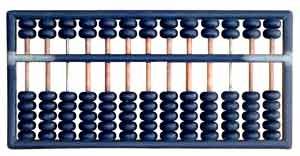

Each column of beads represents one decimal place. The decimal point can be set anywhere, depending on how many fractional digits are required. This abacus can thus handle numbers up to 999,999,999.9999, with an accuracy of four decimal places, if the decimal point is set between the fourth and fifth column from the right.
Beads below the centre support count for 1, beads above count for 5. Numbers are presented by moving beads to the centre support. Thus, the number 7.1 would be represented by moving two of the lower beads of column five up, one of the upper beads on column five down and one of the lower beads of column four up:

The second bead in the upper section is obviously superfluous, since moving two upper beads down in one column is equivalent to moving one lower bead up in the next column to the left. It is used for convenience during calculations. The Japanese version of the abacus known as the soroban dispensed with it and has thus only one bead per column in the upper section.